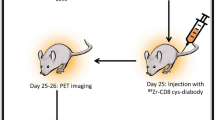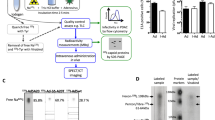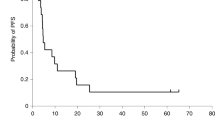Abstract
Molecular imaging of a suicide transgene's expression will aid the development of efficient and precise targeting strategies, and imaging for cancer cell viability may assess therapeutic efficacy. We used the PET reporter probe, 9-(4-[18F]fluoro-3-(hydroxymethyl)butyl)guanine ([18F]FHBG) to monitor the expression of a mutant Herpes Simplex Virus 1 thymidine kinase (HSV1-sr39tk) in C6 glioma tumors implanted subcutaneously in nude mice that were repetitively being treated with the pro-drug Ganciclovir (GCV). [18F]-Fluorodeoxyglucose ([18F]FDG), a metabolic tracer, was used to assess tumor cell viability and therapeutic efficacy. C6 glioma tumors stably expressing the HSV1-sr39tk gene (C6sr39) accumulated [18F]FHBG prior to GCV treatment. Significant declines in C6sr39 tumor volumes and [18F]FHBG and [18F]FDG accumulation were observed following 2 weeks of GCV treatment. However, 3 weeks after halting GCV treatment, the tumors re-grew and [18F]FDG accumulation increased significantly; in contrast, tumor [18F]FHBG concentrations remained at background levels. Therefore, [18F]FHBG can be used to detect tumors expressing HSV1-sr39tk, susceptible to regression in response to GCV exposure, and the effectiveness of GCV therapy in eradicating HSV1-sr39tk-expressing cells can be monitored by [18F]FHBG scanning. [18F]FHBG and [18F]FDG imaging data indicate that exposure of C6sr39 tumors to GCV causes the elimination of [18F]FHBG-accumulating C6sr39 cells and selects for re-growth of tumors unable to accumulate [18F]FHBG.
This is a preview of subscription content, access via your institution
Access options
Subscribe to this journal
Receive 12 print issues and online access
$259.00 per year
only $21.58 per issue
Buy this article
- Purchase on Springer Link
- Instant access to full article PDF
Prices may be subject to local taxes which are calculated during checkout






Similar content being viewed by others
References
Hoekstra CJ, Paglianiti I, Hoekstra OS, et al. Monitoring response to therapy in cancer using [18F]-2-fluoro-2-deoxy-D-glucose and positron emission tomography: an overview of different analytical methods. Eur J Nucl Med. 2000;27:731–743.
Smith TAD . FDG uptake, tumour characteristics and response to therapy: a review. Nucl Med Commun. 1998;19:97–105.
Kitagawa Y, Sadato N, Azuma H, et al. FDG PET to evaluate combined intra-arterial chemotherapy and radiotherapy of head and neck neoplasms. J Nucl Med. 1999;40:1132–1137.
Namba H, Iwadate Y, Iyo M, et al. Glucose and methionine uptake by rat brain tumor treated with pro-drug activated gene therapy. Nucl Med Biol. 1998;25:247–250.
Haberkorn U, Altmann A, Morr I, Germann C, Oberdorfer F, Van Kaick G . Multitracer studies during gene therapy of hepatoma cells with Herpes Simplex Virus Thymidine kinase and Ganciclovir. J Nucl Med. 1997;38:1048–1054.
Dekker B, Keen H, Zweit J, et al. Detection of cell death using 124I-Annexin V (Abstract #256). J Nucl Med. 2002;43:71.
Sugawara Y, Zasadny KR, Grossman HB, Francis IR, Clarke MF, Wahl RL . Germ cell tumor: differentiation of viable tumor, mature teratoma, and necrotic tissue with FDG PET and kinetic modeling. Radiology. 1999;211:249–256.
Krohn KA, Mankoff DA, Eary JF . Imaging cellular proliferation as a measure of response to therapy. J Clin Pharmacol. 2001;41:96S–103S.
Yazawa K, Fisher WE, Brunicardi FC . Current progress in suicide gene therapy for cancer. World J Surg. 2002;26:783–789.
Chatziioannou AF, Cherry SR, Shao Y, et al. Performance evaluation of microPET: a high resolution lutetium oxyorthosilicate PET scanner for animal imaging. J Nucl Med. 1999;40:1164–1175.
Chatziioannou AF . PET scanners dedicated to molecular imaging of small animal models. Mol Imag Biol. 2002;4:47–63.
Gambhir SS, Barrio JR, Herschman HR, Phelps ME . Assays for noninvasive imaging of reporter gene expression. Nucl Med Biol. 1999;26:481–490.
Herschman HR, MacLaren DC, Iyer M, et al. Seeing is believing: non-invasive, quantitative and repetitive imaging of reporter gene expression in living animals, using positron emission tomography. J Neurosci Res. 2000;59:699–705.
Gambhir SS, Barrio J, Wu L, et al. Imaging of adenoviral directed herpes simplex virus type 1 thymidine kinase gene expression in mice with ganciclovir. J Nucl Med. 1998;39:2003–2011.
Gambhir SS, Barrio JR, Phelps ME, et al. Imaging adenoviral-directed reporter gene expression in living animals with positron emission tomography. Proc Natl Acad Sci. 1999;96:2333–2338.
Iyer M, Barrio JR, Namavari M, et al. 8-[18F]Fluoropenciclovir: an improved reporter probe for imaging HSV1-tk reporter gene expression in vivo using PET. J Nucl Med. 2001;42:96–105.
Tjuvajev JG, Avril N, Oku T, et al. Imaging herpes virus thymidine kinase gene transfer and expression by positron emission tomography. Cancer Res. 1998;58:4333–4341.
Gambhir SS, Herschman HR, Cherry SR, et al. Imaging transgene expression with radionuclide imaging technologies. Neoplasia. 2000;2:118–138.
MacLaren DC, Gambhir SS, Satyamurthy N, et al. Repetitive, non-invasive imaging of the dopamine D2 receptor as a reporter gene in living animals. Gene Therapy. 1999;6:785–791.
Groot-Wassink T, Aboagye EO, Wang Y, Lemoine NR, Reader AJ, Vassaux G . Quantitative imaging of Na/I symporter transgene expression using positron emission tomography in the living animal. Mol Ther. 2004;9:436–442.
Yu Y, Annala AJ, Barrio JR, et al. Quantification of target gene expression by imaging reporter gene expression in living animals. Nat Med. 2000;6:933–937.
Yaghoubi SS, Wu L, Liang Q, et al. Direct correlation between positron emission tomographic images of two reporter genes delivered by two distinct adenoviral vectors. Gene Therapy. 2001;8:1072–1080.
Sun X, Annala AJ, Yaghoubi SS, et al. Quantitative imaging of gene induction in living animals. Gene Therapy. 2001;8:1572–1579.
Ray P, Bauer E, Iyer M, et al. Monitoring gene therapy with reporter gene imaging. Semin Nucl Med. 2001;31:312–320.
Liang Q, Gotts J, Satyamurthy N, et al. Noninvasive, repetitive, quantitative measurement of gene expression from a bicistronic message by positron emission tomography, following gene transfer with adenovirus. Mol Ther. 2002;6:73–82.
Black ME, Kokoris MS, Sabo P . Herpes simplex virus-1 thymidine kinase mutants created by semi-random sequence mutagenesis improve prodrug-mediated tumor cell killing. Cancer Res. 2001;61:3022–3026.
Gambhir SS, Bauer E, Black ME, et al. A Mutant herpes simplex virus type 1 thymidine kinase reporter gene shows improved sensitivity for imaging reporter gene expression with positron emission tomography. Proc Natl Acad Sci. 2000;97:2785–2790.
Alauddin MM, Conti PS . Synthesis and preliminary evaluation of 9-(4-[18F]-fluoro-3-hydroxymethylbutyl)guanine ([18F]FHBG): a new potential imaging agent for viral infection and gene therapy using PET. Nucl Med Biol. 1998;25:175–180.
Yaghoubi SS, Barrio JR, Dahlbom M, et al. Human pharmacokinetic and dosimetry studies of [18F]FHBG: a reporter probe for imaging herpes simplex virus type-1 thymidine kinase reporter gene expression. J Nucl Med. 2001;42:1225–1234.
Min J, Iyer M, Gambhir SS . Comparison of [18F]FHBG and [14C]FIAU for imaging of HSV1-tk reporter gene expression: adenoviral infection vs stable transfection. Eur J Nucl Med Mol Imag. 2003;30:1547–1560.
Kokoris MS, Sabo P, Adman ET, Black ME . Enhancement of tumor ablation by a selected HSV-1 thymidine kinase mutant. Gene Therapy. 1999;6:1415–1426.
Hamacher K, Coenen H, Stocklin G . Efficient stereospecific synthesis of no-carrier-added 2[18F]-fluoro-2-deoxy-D-glucose using amino polyether supported nucleophilic substitution. J Nucl Med. 1986;27:235–238.
Qi J, Leahy RM, Hsu C, Farquhar TH, Cherry SR . Fully 3D Bayesian image reconstruction for the ECAT EXACT HR+. IEEE Trans Nucl Sci. 1998;45:1096–1103.
Chatziioannou A, Qi J, Moore A, Annala A, Nguyen K, Leahy R . Comparison of 3-D maximum a posteriori and filtered back projection algorithms for high-resolution animal imaging with microPET. IEEE Trans Med Imag. 2000;19:507–512.
Gambhir S . Quantitation of the Physical Factors Affecting the Tracer Kinetic Modeling of Cardiac Positron Emission Tomography Data. Biomathematics. Los Angeles: University of California; 1990: 353.
Sambrook J, Russel DW . Preparation and analysis of eukaryotic genomic DNA. In: Sambrook J, Russel DW, eds. Molecular Cloning: A Laboratory Manual. 3rd edn., vol 1. New York: Cold Spring Harbor Laboratory Press; 2001: 6.1–6.64.
Haberkorn U, Bellemann ME, Gerlach L, et al. Uncoupling of 2-fluoro-2-deoxyglucose transport and phosphorylation in rat hepatoma during gene therapy with HSV thymidine kinase. Gene Therapy. 1998;5:880–887.
Freeman SM, Ramesh R, Marrogi AJ . Immune system in suicide-gene therapy. Lancet. 1997;349:2–3.
Floeth FW, Shand N, Bojar H, et al. Local inflammation and devascularization—in vivo mechanisms of the “bystander effect” in VPC-mediated HSV-TK/GCV gene therapy for human malignant glioma. Cancer Gene Ther. 2001;8:843–851.
Ishimori T, Saga T, Mamede M, et al. Increased 18F-FDG uptake in a model of inflammation: Concanavalin A-mediated lymphocyte activation. J Nucl Med. 2002;43:658–663.
Barba D, Hardin J, Jasodhara R, Gage FH . Thymidine kinase-mediated killing of rat brain tumors. J Neurosurg. 1993;79:729–735.
Acknowledgements
We thank Ron Sumida, David Stout, Waldemar Ladno, and Judy Edwards for assistance with MicroPET imaging and the UCLA cyclotron crew for outstanding support in the synthesis of imaging tracers. This work was partially supported by funding from NIH Grants P50 CA86306, RO1 CA82214-01, and SAIRP R24 CA92865 DOE contract DE-FC03-87ER60615. This work was partially supported by funding from NIH Grants P50 CA86306, RO1 CA82214-01, and SAIRP R24 CA92865 DOE contract DE-FC03-87ER60615.
Author information
Authors and Affiliations
Corresponding author
Rights and permissions
About this article
Cite this article
Yaghoubi, S., Barrio, J., Namavari, M. et al. Imaging progress of herpes simplex virus type 1 thymidine kinase suicide gene therapy in living subjects with positron emission tomography. Cancer Gene Ther 12, 329–339 (2005). https://doi.org/10.1038/sj.cgt.7700795
Received:
Published:
Issue Date:
DOI: https://doi.org/10.1038/sj.cgt.7700795
Keywords
This article is cited by
-
Synthesis and Characterization of 9-(4-[18F]Fluoro-3-(hydroxymethyl)butyl)-2-(phenylthio)-6-oxopurine as a Novel PET Agent for Mutant Herpes Simplex Virus Type 1 Thymidine Kinase Reporter Gene Imaging
Molecular Imaging and Biology (2020)
-
A triple suicide gene strategy that improves therapeutic effects and incorporates multimodality molecular imaging for monitoring gene functions
Cancer Gene Therapy (2013)
-
Prodrug enzymes and their applications in image-guided therapy of cancer: tracking prodrug enzymes to minimize collateral damage
Drug Delivery and Translational Research (2012)
-
[18F]FLT PET for Non-Invasive Monitoring of Early Response to Gene Therapy in Experimental Gliomas
Molecular Imaging and Biology (2011)



